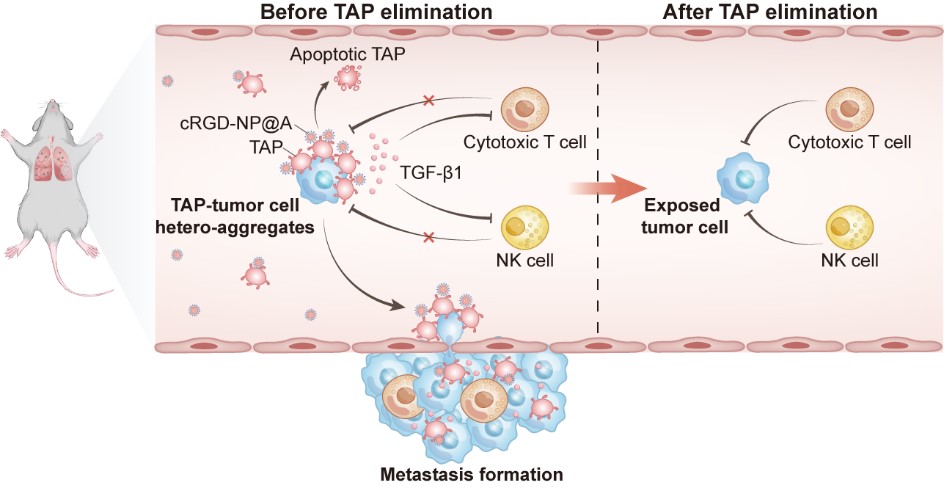Metastasis, or the spread of cancer from its original location to other parts of the body, remains the leading cause of cancer-related deaths and is a major challenge in cancer treatment. Immunotherapy, especially PD-1/PD-L1 inhibitors, activates the immune system to combat cancer and has become an important tool in treating metastatic cancers. However, it works well for only a small group of patients, and many others don’t benefit from it. Finding ways to make PD-1/PD-L1 therapy more effective is key to improving treatment outcomes for patients with metastatic cancer. A recent study published in Cell Reports Medicine led by Prof. NIE Guangjun and Prof. LI Suping from the National Center for Nanoscience and Technology (NCNST) reveals a close connection between platelets and antitumor immunity, offering a promising strategy to overcome the limited response to PD-1 therapy.
Platelets, the second most common cells in our blood, are essential players in cancer metastasis. When cancer cells travel through the bloodstream to spread to other parts of the body, they are vulnerable to damage from blood flow and attacks from the immune system. However, platelets can quickly attach to the surface of cancer cells, forming a protective shield and secreting bioactive substances that suppress immune cell activity. Of note, only a small fraction of platelets in the blood are involved in cancer metastasis, while platelets are essential for normal blood clotting. Therefore, the ideal treatment should specifically target the tumor-associated platelets involved in metastasis, without harming the normal platelets needed to stop bleeding.
Nanotechnology offers an innovative solution to this issue. To specifically target and remove tumor-associated platelets, researchers led by Prof. NIE Guangjun and Prof. LI Suping created polymeric nanoparticles with a special peptide named cRGD on their surface, which was attached through chemical bonding. This cRGD peptide binds to receptors found mainly on tumor-associated platelets, which are rarely present on normal platelets. By using a polymer called PLGA-PEG, which has both water-loving and water-repelling parts, the researchers were able to enclose a drug called ABT-737 (which eliminates platelets) in the nanoparticle's core. The cRGD peptide helps guide the nanoparticles to tumor-associated platelets, where they are taken in and removed from circulation. This process prevents these platelets from helping cancer spread. Importantly, this targeted delivery method only affects the platelets involved in metastasis, leaving normal platelets unaffected, which is crucial for preserving their ability to help with blood clotting.
“A few studies on platelet-derived immunosuppressive factors in tumors caught our attention,” says Prof. LI Suping, a researcher at NCNST and the lead author of the study. “Since platelets actively promote metastasis and PD-1 inhibitors have shown limited effectiveness in treating metastatic cancer, we believed that combining platelet targeting with PD-1 therapy could have a synergistic effect, enhancing PD-1's efficacy through multiple mechanisms.” She adds, “Indeed, specifically removing tumor-associated platelets significantly improves the effectiveness of PD-1 therapy. This happens not only by preventing platelets from aiding tumor metastasis, but also by depleting immunosuppressive factors derived from tumor-associated platelets, which strengthens the immune responses triggered by PD-1 therapy.”
“This work establishes a crucial connection between tumor-associated platelet targeting and immune therapeutic efficacy enhancement, offering a promising strategy to improve the limited response rates of and clinical outcomes for metastatic cancer patients undergoing PD-1 therapy” says Prof. NIE Guangjun, the senior author of the current work.
The researchers developed a polymeric nanodrug designed to specifically remove tumor-associated platelets. By disrupting the interaction between platelets and tumors, this nanodrug reduces immunosuppressive factors released by platelets and exposes tumor cells to the immune system. As a result, it boosts the effectiveness of PD-1 therapy in fighting metastasis and offers a new approach to improving its response rates in patients with metastatic cancer.

Schematic illustration of the action mechanisms of cRGD-NP@A (Image by the research group).
Contact:
Guangjun Nie
National Center for Nanoscience and Technology (NCNST)
E-mail: niegj@nanoctr.cn
Suping LI
National Center for Nanoscience and Technology (NCNST)
E-mail: lisuping@nanoctr.cn




